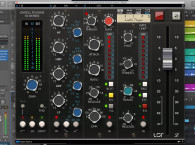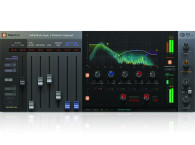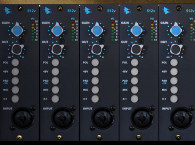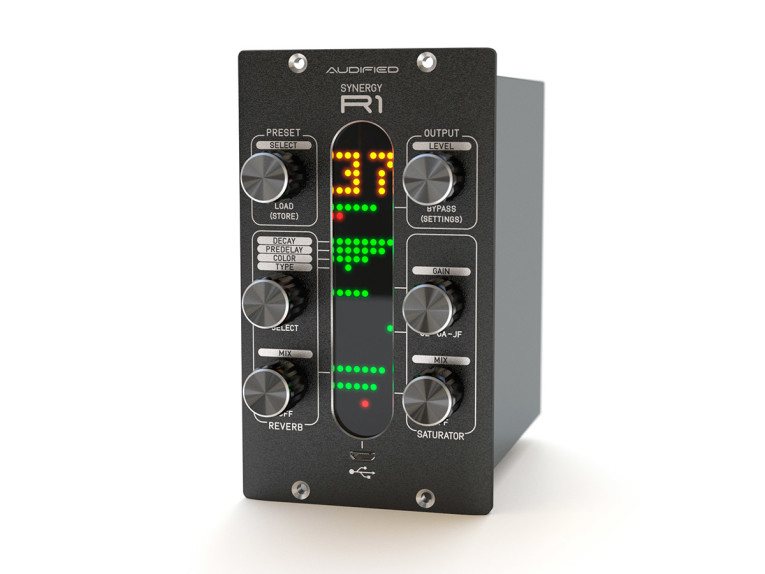
The SYNERGY R1 processor combines a studio reverb with seven types of algorithms in synergy with three kinds of true analogue saturation, remotely-controlled from any DAW (Digital Audio Workstation) with an outstanding sound and world-class user interface. Boris Carloff, Czech composer/producer, and the SYNERGY R1 designer says that the SYNERGY R1 "it’s a must-have processor for every studio — project or commercial.”
Modern-day producers tend to shy away from audio hardware effects in this day and age. Why? Well, the luxury of recalling such sessions like yesteryear’s production pros is a time-consuming process and shrinking production budgets dictate that today’s time-stressed producers often take to sacrificing CPU (Central Processing Unit) power for plug-in processing convenience. Conceptually — and in reality, as a ‘remote-controlled’ software/hardware hybrid digital (REVERB)/analogue (SATURATOR) processing module for the 500 series modular rack frame format, the SYNERGY R1 is an altogether different production proposition. According to the Czech company, users can control the device from their DAW, automate it, and store session settings, courtesy of its easily accessible, front facia-positioned USB (Universal Serial Bus) connection. And that’s just for starters.

Seriously designed and sturdily built in the Czech Republic, beating at SYNERGY R1’s hardware heart are two switchable sections. REVERB is digital, providing premium-quality 24-bit A/D (analogue-to-digital) and D/A (digital-to-analogue) convertors, 32-bit floating point DSP (Digital Signal Processing) and true BYPASS functionality. In this section there are seven selectable reverb algorithms (simulating several different types of spatial acoustics), ranging from Room all the way up to Tunnel, and users can control four front panel-accessible parameters: DECAY, PREDELAY, COLOR, and TYPE.
The second — true analogue — SATURATOR section features three switchable saturation circuits with GE (Germanium), OA (OpAmp), and JF (J-FET) types (that add harmonics to the signal) and a GAIN control. Centrally positioned, a distinctive display is packed with Light Emitting Diodes to assist with parameter editing visually via numeric and bar indication of values — LEDs for the edited parameter change color to yellow and the value is visible in the numeric part of the display while other parameter LEDs remain green; when editing is finished, the display returns to the default view — numeric area displaying preset number and all value indicators in green... or red if the parameter is switched off. Both sections include wet/dry MIX controls, so SYNERGY R1 can be used as a 100% digital reverb or a 100% analogue saturator (and anything between those two worlds).

What truly sets SYNERGY R1 apart from the run-of-the-mill 500 series pack, however, is that each and every one of its functions can be remote controlled via the included SYNERGY R1 plug-in that can be used from within all major DAW host applications on Mac and PC (with AAX, AU, VST2, and VST3 support). Hardware parameters can be fully automated and are saved within projects. The control plug-in supports multi-instance usage, so several plug-ins could be assigned to one hardware unit. Also included is a standalone SYNERGY R1 control application, allowing for independent control of SYNERGY R1 via Mac or PC. Production pros of old school-style thinking, of course, can still get hands-on with the hardware itself... if they wish to do so!
“I’m a reverb guy,” gushes Boris Carloff. “I own 11 hardware reverb units in my studio, including an EMT 251, Bricasti M7, and AKG BX25 spring reverb — all classics, but I always dreamt of having something with the mellowness of old plate reverbs like the EMT 140. The analogue saturation of overdriving circuitry made their sound so lush, three-dimensional, and significant that I think I prefer them to any of the classic digital reverbs. On the flipside of the coin, I love the versatility of digital’s different algorithms. And, of course, I also like simple DAW control. So something with the best of both the analogue and digital worlds, with all their wonderful possibilities combined, seemed like a good solution to me, which was the thinking behind SYNERGY R1.”
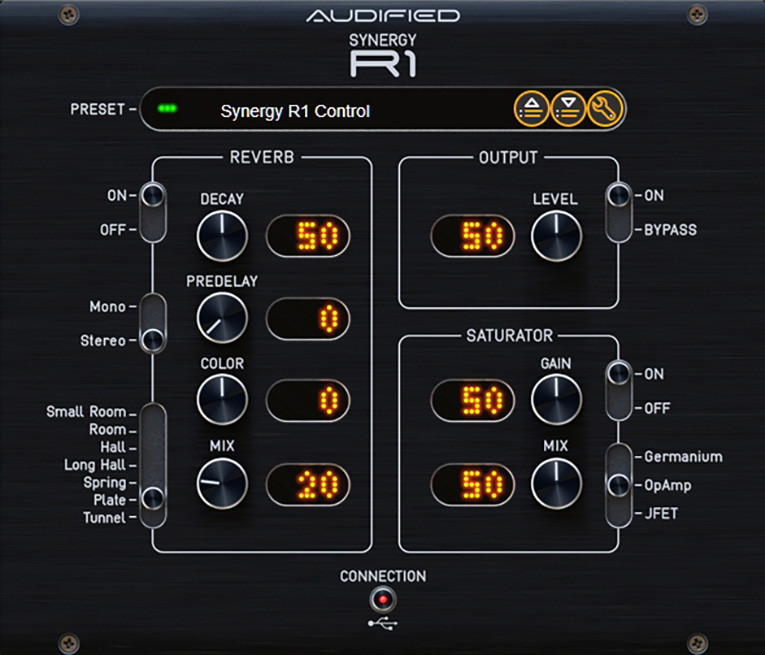
“New high-end algorithms with real analogue saturation makes for an unbelievably lush- and nice-sounding reverb, but there is also an option to use clean digital reverb,” the SYNERGY R1 creator adds. “With real bypass of the digital reverb it is also possible to apply three different types of parallel analogue saturation to your mix.”
An amazing mix of technologies, perfectly packaged into a stereo audio processing module powered by a 500 series lunchbox, but boasting DAW control, carefully tuned reverb algorithms, and the satisfying sound of real analogue circuitry. SYNERGY R1 was introduced by Eleven Dimensions Media (www.11dmedia.com), Audified’s North American distribution partner, at Summer NAMM 2017, and is scheduled to start shipping in September 2017, with a projected MSRP of $1,399.00 USD.
www.audified.com



